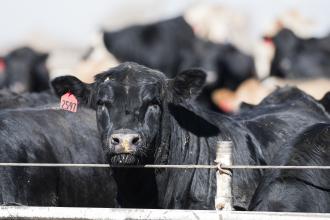
The Humane Methods of Slaughter Act (HMSA) requires the humane treatment and handling of food animals at the slaughter plant while also providing a quick and effective death. The Act was originally passed on August 27, 1958 and is enforced by the USDA Food Safety and Inspection Service (FSIS). In 1978, the Act was amended to allow USDA, FSIS inspectors to stop slaughter activities if they think an animal is being handled inhumanely. HMSA protects all livestock except poultry.
Current Law and Regulations
- Humane Methods of Slaughter Act - Current statute passed by U.S. Congress and incorporated into the United States Code starting at 7 U.S.C. 1901. The statute gives USDA authority to make regulations to implement and enforce the law by issuing regulations.
- Humane Methods of Slaughter Regulations - The Code of Federal Regulations at 9 C.F.R. Part 313 provides detailed guidance and standards drafted and adopted by the USDA to implement and enforce the Humane Methods of Slaughter Act.
Compliance and Enforcement
Compliance Assistance: Humane Methods of Slaughter Act
USDA. Food Safety and Inspection Service (FSIS).
FSIS shares outreach initiatives, training materials and additional resources to help enforce the HMSA.
Non-ambulatory Livestock and the Humane Methods of Slaughter Act
Congressional Research Service (CRS).
CRS's 2009 publication addresses non-ambulatory livestock and the Humane Slaughter Act.
GAO Reports and Testimonies: Humane Methods of Slaughter Act
US Government Accountability Office (GAO).
GAO writes reports regarding the enforcement of the Humane Methods of Slaughter Act.
Frequently Asked Questions
Why aren't poultry (chickens, turkeys, and ducks) protected under the HMSA?
USDA's Federal Register Notice "Treatment of Live Poultry Before Slaughter" states that the Poultry Products Inspection Act (PPIA) (21 U.S.C. § 451 et seq. (2022)) ensures humane slaughter of the birds. The PPIA and its regulations require that live poultry be handled using good commercial practices and that they not die from anything other than slaughter after arriving at the slaughter facility. Since poultry are protected under the PPIA, they are not included under the HMSA.
How is humane handling defined in the HMSA and Regulations?
From Humane Methods of Slaughter Act, 7 U.S.C. § 1902 (2021).
Either of the following two methods of slaughtering and handling are hereby found to be humane:
(a) in the case of cattle, calves, horses, mules, sheep, swine, and other livestock, all animals are rendered insensible to pain by a single blow or gunshot or an electrical, chemical or other means that is rapid and effective, before being shackled, hoisted, thrown, cast, or cut; or
(b) by slaughtering in accordance with the ritual requirements of the Jewish faith or any other religious faith that prescribes a method of slaughter whereby the animal suffers loss of consciousness by anemia of the brain caused by the simultaneous and instantaneous severance of the carotid arteries with a sharp instrument and handling in connection with such slaughtering.
From Part 313-Humane Slaughter of Livestock, 9 C.F.R. § 313.2 (2021).
(a) Driving of livestock from the unloading ramps to the holding pens and from the holding pens to the stunning area shall be done with a minimum of excitement and discomfort to the animals. Livestock shall not be forced to move faster than a normal walking speed.
(b) Electric prods, canvas slappers, or other implements employed to drive animals shall be used as little as possible in order to minimize excitement and injury. Any use of such implements which, in the opinion of the inspector, is excessive, is prohibited. Electrical prods attached to AC house current shall be reduced by a transformer to the lowest effective voltage not to exceed 50 volts AC.
(c) Pipes, sharp or pointed objects, and other items which, in the opinion of the inspector, would cause injury or unnecessary pain to the animal shall not be used to drive livestock.
(d) Disabled livestock and other animals unable to move. (1) Disabled animals and other animals unable to move shall be separated from normal ambulatory animals and placed in the covered pen provided for in §313.1(c). (2) The dragging of disabled animals and other animals unable to move, while conscious, is prohibited. Stunned animals may, however, be dragged. (3) Disabled animals and other animals unable to move may be moved, while conscious, on equipment suitable for such purposes; e.g., stone boats.
(e) Animals shall have access to water in all holding pens and, if held longer than 24 hours, access to feed. There shall be sufficient room in the holding pen for animals held overnight to lie down.
(f) Stunning methods approved in §313.30 shall be effectively applied to animals prior to their being shackled, hoisted, thrown, cast, or cut.
Whom do I contact if I am concerned about the humane handling of animals at a slaughter plant?
Does the HMSA apply to animals slaughtered in foreign countries before the meat is imported to the U.S.?
Yes, according to the HMSA, "No such carcasses, parts of carcasses, meat or meat food products shall be imported into the United States unless the livestock from which they were produced was slaughtered and handled in connection with slaughter in accordance with the Act of August 27, 1958 (72 Stat. 862; 7 U.S.C. 1901–1906)," (21 U.S.C § 620 (a)(2022)).
Horse Slaughter
-
Horse Slaughter Prevention Bills and Issues (PDF | 206 KB)
Congressional Research Service (CRS).
CRS gives an overview of Federal legislation, including proposed laws, relating to the topic of horse slaughter. (Updated August 15, 2012)
-
GAO Report: Horse Welfare - Domestic Slaughter, 2011
Government Accountability Office (GAO).
Congress directed GAO to examine horse welfare since cessation of domestic slaughter in 2007. The study was completed and published on June 22, 2011.

 An official website of the United States government.
An official website of the United States government.